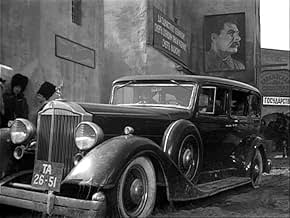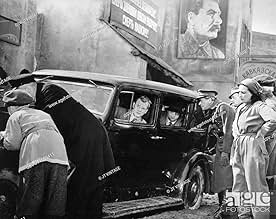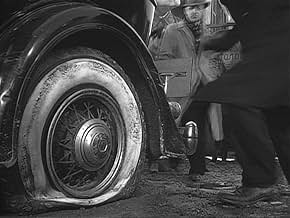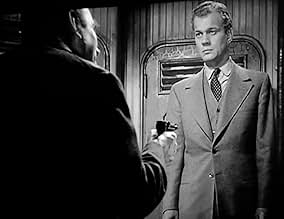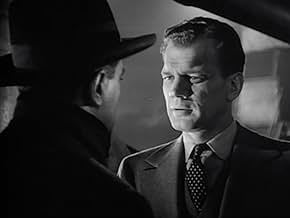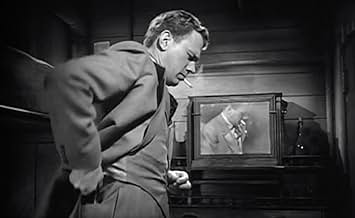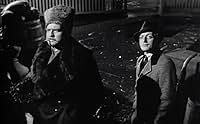An American ballistics expert in Turkey finds himself targeted by German agents. Safe passage home by ship is arranged for him, but he soon discovers that his pursuers are also on board.An American ballistics expert in Turkey finds himself targeted by German agents. Safe passage home by ship is arranged for him, but he soon discovers that his pursuers are also on board.An American ballistics expert in Turkey finds himself targeted by German agents. Safe passage home by ship is arranged for him, but he soon discovers that his pursuers are also on board.
Dolores Del Río
- Josette Martel
- (as Dolores Del Rio)
Anna De Linsky
- Russian Maid at Batumi Hotel
- (uncredited)
Jerome de Nuccio
- Turkish Officer
- (uncredited)
Herbert Drake
- Ship's Steward
- (uncredited)
Featured reviews
The ingredients are there for first-class international intrigue—Welles, Cotten, an Ambler novel, and the terrific RKO team of D' Agostino and Silvera behind so much of the studio's b&w artistry. So why is the end result short of the classic it should be. IMDb lists 3 uncredited writers in addition to the credited Cotten. Maybe that's why the narrative is so choppy as other reviewers point out. Then too, maybe the studio exercised a heavy hand in the editing room as they were known to do. Whatever the reason, the story never really gels into the suspenser it should be, despite the impressive visuals so clearly Wellsian.
Nonetheless, the nightclub scene especially stays with me. Catch the neatly choreographed staging as the characters dart in and out of the foreground reminiscent of the high-kicking dance scene in Citizen Kane. And who else but a magician (Hans Conreid) would trick himself into a casket with such Wellsian flourish. Note too how visually appropriate non- actor Jack Moss is as the "obese gunman". Apparently, he couldn't be entrusted with any lines, but looking like a mutant garden slug he rivets the eye by sinister presence alone. In fact, this may be the kind of film made more enjoyable by turning down the sound and just reveling in the visuals. Yes indeed, the narrative may disappoint, but the very real Wellsian compensations remain.
Nonetheless, the nightclub scene especially stays with me. Catch the neatly choreographed staging as the characters dart in and out of the foreground reminiscent of the high-kicking dance scene in Citizen Kane. And who else but a magician (Hans Conreid) would trick himself into a casket with such Wellsian flourish. Note too how visually appropriate non- actor Jack Moss is as the "obese gunman". Apparently, he couldn't be entrusted with any lines, but looking like a mutant garden slug he rivets the eye by sinister presence alone. In fact, this may be the kind of film made more enjoyable by turning down the sound and just reveling in the visuals. Yes indeed, the narrative may disappoint, but the very real Wellsian compensations remain.
Howard Graham is an American engineer returning from Istanbul with his wife Stephanie. A close call in a Turkish nightclub sees a man assassinated by mistake when really Howard was the target and he and his wife are quickly taken to the Turkish secret police. Colonel Haki informs him that he is a target of the Nazis and immediately gets him transit out of the country on the next available boat while he protects his wife. However Howard quickly finds that he is far from being out of danger as his pursuers are on the boat as well.
With keys part of the Third Man cast involved in this thriller, I decided to take a look and had hoped for a film that perhaps would be as enjoyable as that. However it was not quite all that I hoped it would have been as I didn't find myself that gripped by it. The early scenes suggest a real mystery with a good pace but quickly the mistaken assassination of the magician is slowed down and complicated by unnecessary characters and dialogue, some of which seemed to serve very little purpose other than setting up some other scenes later on. With Mrs Howard away somewhere out of vision and therefore out of mind, we focus on the action on other boat and, although quite tense at points, it didn't have the sort of sustained tension that should have been made easier by the confined location of the boat. It does enough to engage though and I did find it quite enjoyable but those claiming this as a classic up there with some of Welles' other films are mistaken because this is only quite good not any more than that.
The cast was the reason I was here but they were not as good as they have been in other films. Cotton is a bit brash and loud and aspects of his character aren't brought out that well; he was still an interesting leading man but mainly because I have always liked him. Welles has a small role and seems to enjoy himself playing a role that has little screen time but is mentioned throughout the film; I'm not sure if he did direct his own scenes but that is the rumour. Del Rio is sexy and a nice presence but I wasn't overly taken by her other than that. Moss tends to steal the film with his big character lurking around early on, meanwhile the rest of the support are OK, with other languages being spoken rather than the usual American actors putting on vague accents as was often the case (and still is!). Assuming that he did direct the majority, if not all, of the film (and I do believe this) Foster does a very good job of working with shadows in early scenes and in the boat some of his angles are effective, although it is easy to see (with some of his shots) why people generally believe that it was Welles calling the shots.
Overall this is an enjoyable thriller with a dark atmosphere brought out by good direction throughout. The cast are OK but none of the famous faces really stood out for me here, meanwhile the plot was not as tight as it needed to be, leaving some holes and using some distracting plot devices along the way. Still worth seeing but not the classic that it is often touted around as being.
With keys part of the Third Man cast involved in this thriller, I decided to take a look and had hoped for a film that perhaps would be as enjoyable as that. However it was not quite all that I hoped it would have been as I didn't find myself that gripped by it. The early scenes suggest a real mystery with a good pace but quickly the mistaken assassination of the magician is slowed down and complicated by unnecessary characters and dialogue, some of which seemed to serve very little purpose other than setting up some other scenes later on. With Mrs Howard away somewhere out of vision and therefore out of mind, we focus on the action on other boat and, although quite tense at points, it didn't have the sort of sustained tension that should have been made easier by the confined location of the boat. It does enough to engage though and I did find it quite enjoyable but those claiming this as a classic up there with some of Welles' other films are mistaken because this is only quite good not any more than that.
The cast was the reason I was here but they were not as good as they have been in other films. Cotton is a bit brash and loud and aspects of his character aren't brought out that well; he was still an interesting leading man but mainly because I have always liked him. Welles has a small role and seems to enjoy himself playing a role that has little screen time but is mentioned throughout the film; I'm not sure if he did direct his own scenes but that is the rumour. Del Rio is sexy and a nice presence but I wasn't overly taken by her other than that. Moss tends to steal the film with his big character lurking around early on, meanwhile the rest of the support are OK, with other languages being spoken rather than the usual American actors putting on vague accents as was often the case (and still is!). Assuming that he did direct the majority, if not all, of the film (and I do believe this) Foster does a very good job of working with shadows in early scenes and in the boat some of his angles are effective, although it is easy to see (with some of his shots) why people generally believe that it was Welles calling the shots.
Overall this is an enjoyable thriller with a dark atmosphere brought out by good direction throughout. The cast are OK but none of the famous faces really stood out for me here, meanwhile the plot was not as tight as it needed to be, leaving some holes and using some distracting plot devices along the way. Still worth seeing but not the classic that it is often touted around as being.
`Journey Into Fear' certainly has an Orson Welles look. Although he received neither directing nor writing credit (credit went to Norman Foster and Joseph Cotten, respectively), I think that most of what is there is his. The problem is that there is not enough there there. The on-board relationships should have been developed more. All of them seem perfunctory.
Combining the shooting by a good marksman who misses his target and stalking him in the nightclub are combined into an altogether more satisfying single event.The escape from the Nazis is more protracted and less violent than in Eric Ambler's book. It is very noirish and photogenic, and the combination of wet chase and the presence of a murky character played by Orson Welles and an all-American one played by Joseph Cotten prefigure `The Third Man.' Joseph Cotten had some of the same American innocence and ready outrage in both films. He's an important munitions engineer here and a hack western writing there. He doesn't get the dark beauty (Alida Valli or Dolores del Rio) in either, though he has and keeps a wife in `Journey.'
The film probably makes sense to those unfamiliar with the book (and such viewers aren't distracted by thinking about what's been changed). It is suspenseful even for someone like me who recently read the book
Combining the shooting by a good marksman who misses his target and stalking him in the nightclub are combined into an altogether more satisfying single event.The escape from the Nazis is more protracted and less violent than in Eric Ambler's book. It is very noirish and photogenic, and the combination of wet chase and the presence of a murky character played by Orson Welles and an all-American one played by Joseph Cotten prefigure `The Third Man.' Joseph Cotten had some of the same American innocence and ready outrage in both films. He's an important munitions engineer here and a hack western writing there. He doesn't get the dark beauty (Alida Valli or Dolores del Rio) in either, though he has and keeps a wife in `Journey.'
The film probably makes sense to those unfamiliar with the book (and such viewers aren't distracted by thinking about what's been changed). It is suspenseful even for someone like me who recently read the book
While returning from a conference munitions expert Joseph Cotten and his wife Ruth Warrick are taken to a nightclub in Istanbul by the mysterious Edward Sloane where Cotten is almost killed. Magician Hans Conreid is a victim of his own slight of hand, but it's Cotten who's the target as Orson Welles as the Turkish police inspector deduces.
Welles's solution get Cotten out of the country so if he's killed at least it won't be on his watch. Welles books passage on a tramp freighter for Cotten and the freighter is loaded with highly interesting characters, one of whom at least is a Nazi assassin.
This was another Mercury Theater production with most of the regulars from Citizen Kane/The Magnificent Ambersons back again. Welles's police inspector is a small, but crucial part of the story.
Welles, for whatever reason is being unduly modest. Journey Into Fear is undoubtedly the greatest film that Orson Welles never took credit for directing. I can find certain touches here from Citizen Kane, The Magnificent Ambersons, and The Stranger. If he didn't officially direct you can take it to the bank that Norman Foster knew exactly what Welles was trying to get out of each and every scene.
Look also here for a good performance by Mexican cinema great Dolores Del Rio as a most mysterious femme fatale on the freighter.
Journey Into Fear is a short film, slightly less than 70 minutes running time. I'm sure that RKO had it playing at the bottom end of double features. Maybe we'll see a 'director's cut' of this one day and know what Welles's own perspective was.
Welles's solution get Cotten out of the country so if he's killed at least it won't be on his watch. Welles books passage on a tramp freighter for Cotten and the freighter is loaded with highly interesting characters, one of whom at least is a Nazi assassin.
This was another Mercury Theater production with most of the regulars from Citizen Kane/The Magnificent Ambersons back again. Welles's police inspector is a small, but crucial part of the story.
Welles, for whatever reason is being unduly modest. Journey Into Fear is undoubtedly the greatest film that Orson Welles never took credit for directing. I can find certain touches here from Citizen Kane, The Magnificent Ambersons, and The Stranger. If he didn't officially direct you can take it to the bank that Norman Foster knew exactly what Welles was trying to get out of each and every scene.
Look also here for a good performance by Mexican cinema great Dolores Del Rio as a most mysterious femme fatale on the freighter.
Journey Into Fear is a short film, slightly less than 70 minutes running time. I'm sure that RKO had it playing at the bottom end of double features. Maybe we'll see a 'director's cut' of this one day and know what Welles's own perspective was.
Orson Welles graciously denied having any directing role in Norman Foster's 'Journey into Fear (1943),' though his influence appears to be all over it. 'Citizen Kane (1941)' first showcased Welles' fondness for filming people via low and high-angled cameras, a stylistic technique that distorts statures, placing the audience in a position either of power or helplessness. Here, the talented Karl Struss who also worked on such films as 'Sunrise: A Song of Two Humans (1927)' and 'Dr. Jekyll and Mr. Hyde (1931)' employs similar techniques, capturing human faces with a threatening immediacy that distorts their features and suggests imminent danger. You won't, of course, fail to notice that the film's cast also boasts more than a few Welles regulars, mostly members of his Mercury Theatre team Joseph Cotten, Agnes Moorehead, Everett Sloane, Ruth Warrick and Welles himself. The film's screenplay was written by Cotten, his sole attempt at writing {outside some uncredited work on 'The Magnificent Ambersons (1942)'}, a pity since the dialogue is frequently crisp, intelligent and memorable.
'Journey into Fear' is one of those rare WWII-themed films of the early 1940s that you wouldn't automatically class as propaganda. Indeed, the Nazis are only mentioned in passing, and the sinister agents who attempt to assassinate Cotten could just as easily be motivated by reasons other than war. Much of the story takes place on a small passenger ship, on which American engineer Howard Graham (Cotten) seeks refuge from German assassins, who are hell-bent on delaying his return home with important Allied intelligence. Silent enemy Peter Banat (played by Welles' agent, Jack Moss) watches ominously from across the ship's cabin, never saying a word, but suggesting sadistic menace through every dryly-amused smirk. Cotten is strong in the lead role, playing Graham as a frightened and confused amateur, a role reminiscent of Holly Martins from 'The Third Man (1949),' rather than the experienced and resourceful American spy we would otherwise expect in such a film. Welles lends his mighty presence to the role of the Turkish Colonel Haki, though he is noticeably more subdued than usual.
In one final manner, 'Journey into Evil' is very much like an Orson Welles film: it was re-edited at the studio's request. According to some sources, Welles did some of the trimming himself, recutting the final reel and adding Joseph Cotten's rather awkward narration. At just 68 minutes in length, the film certainly feels as though it has been tampered with. The relationship between Graham and Rosette (Dolores del Rio) is brief and poorly explored, and certainly not worthy of the repeated reassurances that the former frequently bestows upon his anxious wife (Ruth Warrick); there's little indication that the their affiliation extended beyond exchanging a few harmless pleasantries. Though the film doesn't exactly feel incomplete as did a noir like Renoir's 'The Woman on the Beach (1947)' the bare-bones narrative gives the sense of a minor and inconsequential work. Even so, 'Journey into Evil' is well worth seeking out for its terrific photography including a superb climax on the slippery ledges of a hotel exterior and the talents of a very talented cast.
'Journey into Fear' is one of those rare WWII-themed films of the early 1940s that you wouldn't automatically class as propaganda. Indeed, the Nazis are only mentioned in passing, and the sinister agents who attempt to assassinate Cotten could just as easily be motivated by reasons other than war. Much of the story takes place on a small passenger ship, on which American engineer Howard Graham (Cotten) seeks refuge from German assassins, who are hell-bent on delaying his return home with important Allied intelligence. Silent enemy Peter Banat (played by Welles' agent, Jack Moss) watches ominously from across the ship's cabin, never saying a word, but suggesting sadistic menace through every dryly-amused smirk. Cotten is strong in the lead role, playing Graham as a frightened and confused amateur, a role reminiscent of Holly Martins from 'The Third Man (1949),' rather than the experienced and resourceful American spy we would otherwise expect in such a film. Welles lends his mighty presence to the role of the Turkish Colonel Haki, though he is noticeably more subdued than usual.
In one final manner, 'Journey into Evil' is very much like an Orson Welles film: it was re-edited at the studio's request. According to some sources, Welles did some of the trimming himself, recutting the final reel and adding Joseph Cotten's rather awkward narration. At just 68 minutes in length, the film certainly feels as though it has been tampered with. The relationship between Graham and Rosette (Dolores del Rio) is brief and poorly explored, and certainly not worthy of the repeated reassurances that the former frequently bestows upon his anxious wife (Ruth Warrick); there's little indication that the their affiliation extended beyond exchanging a few harmless pleasantries. Though the film doesn't exactly feel incomplete as did a noir like Renoir's 'The Woman on the Beach (1947)' the bare-bones narrative gives the sense of a minor and inconsequential work. Even so, 'Journey into Evil' is well worth seeking out for its terrific photography including a superb climax on the slippery ledges of a hotel exterior and the talents of a very talented cast.
Did you know
- TriviaThe great stage actor Richard Bennett had been brought back to films by Orson Welles for "The Magnificent Ambersons". Although his performance as old Major Amberson has become legendary, it was achieved with great difficulty, as Bennett, by then an old man near death, found it hard to remember his lines and his eyesight was too poor for him to be able to read them off cue-cards. Welles's patience in dealing with these problems has been widely described. When he cast Bennett in this film as the ship's captain, he overcame the problems very simply, by giving Bennett no dialogue at all, although the character has several memorable scenes. It was to be Bennett's final film role.
- GoofsDuring the chase outside the hotel in the rain, Banat's pistol, a P-08 "Luger" runs out of ammunition, but the action closes normally after he fires the last shot. This particular pistol was designed so that the action stays open after the last round is fired, giving a clear indication to the user that the gun is empty.
- Quotes
Colonel Haki: Ah, you have this advantage over the soldier, Mr. Graham. You can run away without being a coward.
- Alternate versionsIn 2005 an alternate cut was shown at the Welles film retrospective in Locarno, Switzerland. It was the original European release print, lacking the narration and ending of the US version but including about eight minutes of footage later deleted by RKO, reportedly for political and censorship reasons. This alternate version, assembled by Stefan Droessler of the Munich Filmmuseum, was shown at the Museum of Modern Art on Sat, Nov 21, 2015
- ConnectionsFeatured in Terminus... the Theater of Science Fiction: Journey into Fear (1970)
- SoundtracksC'est mon coeur
(uncredited)
Written by Steven Morgan
- How long is Journey Into Fear?Powered by Alexa
Details
- Release date
- Country of origin
- Languages
- Also known as
- Jornada de terror
- Filming locations
- Production companies
- See more company credits at IMDbPro
- Runtime1 hour 8 minutes
- Color
- Aspect ratio
- 1.37 : 1
Contribute to this page
Suggest an edit or add missing content


